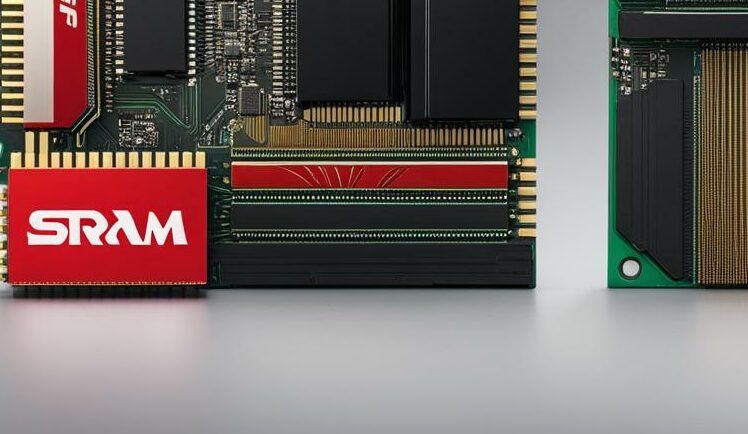Have you ever wondered what memory technology your computer or mobile device relies on? Two of the most common types of memory technologies are SRAM (Static Random-Access Memory) and DRAM (Dynamic Random-Access Memory). While they serve the same purpose of storing and accessing data in digital devices, there are significant differences between the two.
In this comprehensive guide, we will explain the fundamental difference between SRAM and DRAM, explore their functionality, compare their unique attributes, and help you grasp their significance in modern technology.
Key Takeaways:
- SRAM and DRAM are two of the most common types of memory technologies.
- Understanding the differences between SRAM and DRAM is crucial for making informed decisions about their usage in different scenarios.
- SRAM is known for its speed, while DRAM is known for its cost-effectiveness and density.
- Real-world applications of SRAM and DRAM include computer systems, mobile devices, and embedded systems.
SRAM vs. DRAM: An Overview
If you’re wondering about the difference between SRAM and DRAM, you’re in the right place. These two types of memory are commonly used in computer systems and other electronic devices, and understanding their differences is crucial for making informed decisions about their usage.
Let’s start with the basics: both SRAM and DRAM are types of random-access memory (RAM), which means they allow data to be accessed quickly and randomly. However, there are fundamental differences between the two that affect their performance, cost, and other factors.
One of the main differences between SRAM and DRAM is the way they store data. SRAM uses a flip-flop circuit to store each bit of data, which makes it faster and more expensive than DRAM. In contrast, DRAM uses a capacitor and transistor to store each bit, which makes it slower but also cheaper and more dense than SRAM.
Another difference is the way they maintain data. SRAM is static, which means it doesn’t need to be refreshed constantly to maintain its data. This makes it ideal for applications where speed is critical, such as cache memory in computer systems. DRAM, on the other hand, is dynamic, which means it needs to be refreshed constantly to maintain its data. This makes it more suitable for applications where cost and density are more important than speed, such as main memory in computer systems.
Overall, SRAM and DRAM have their unique advantages and trade-offs, which we’ll explore in more detail in the following sections.
Functionality and Operations of SRAM
SRAM (Static Random-Access Memory) is a type of memory technology commonly used in cache memory and fast processors due to its high-speed read and write capabilities. Unlike DRAM, which stores data in tiny capacitors, SRAM uses electronic flip-flops to store data, making it faster and more reliable.
The electronic flip-flops used in SRAM provide a high level of stability that allows the data to remain intact without the need for constant refreshing. This makes SRAM faster than DRAM because data can be accessed without any delay. The flip-flops also require less power, making SRAM more energy-efficient than DRAM.
SRAM’s functionality is based on the use of transistors, which allow data to be stored and retrieved. The transistors are arranged in a matrix of rows and columns, with each intersection of a row and column forming a memory cell. Each memory cell stores a single bit of data (either 1 or 0).
The read and write operations of SRAM are simple and fast. During a read operation, the address of the data is supplied to the memory chip, and the data is accessed instantly. In a write operation, the new data is written directly to the memory cell, replacing the previous contents.
One of the key advantages of SRAM is its quick response time. Because the data is stored in flip-flops, it can be accessed with minimal delay, providing faster performance than other types of memory. However, this speed comes at a cost – SRAM is more expensive to manufacture than other types of memory due to its complex composition.
In conclusion, SRAM is a fast and reliable memory technology that is commonly used in cache memory and processors. Its functionality is based on electronic flip-flops, which provide stability and speed, but also make it more expensive than other types of memory. Overall, SRAM is an important component of modern technology that continues to advance and improve with each new generation.
Functionality and Operations of DRAM
Dynamic Random-Access Memory (DRAM) is a type of volatile memory technology that stores data in a capacitor. DRAM is commonly used in personal computers, mobile devices, and other electronic devices for its high storage density and low cost.
DRAM works by using a transistor and a capacitor to store each bit of data. When a bit is written to the DRAM, a charge is stored in the capacitor. However, because of the capacitor’s structure, this charge gradually leaks away over time. Therefore, DRAM must be refreshed periodically to maintain its content. The process of refreshing DRAM is called dynamic refresh.
DRAM’s read and write operations are slower than those of SRAM. When data is read from DRAM, the charge in the capacitor is amplified and sent to the data bus. When data is written, a signal is sent to the transistor, which charges or discharges the capacitor according to the value of the bit.
DRAM has a higher storage density than SRAM due to the simple structure of its memory cell. However, DRAM has several limitations. It requires constant refreshing, which consumes power and causes latency. Additionally, DRAM is more susceptible to errors caused by noise and interference.
Synchronous DRAM (SDRAM) and Double Data Rate (DDR)
Synchronous DRAM (SDRAM) is a type of DRAM that synchronizes its operation with the system clock, enabling faster access times. SDRAM is used in computer systems and is available in various types such as DDR SDRAM, DDR2 SDRAM, DDR3 SDRAM, and DDR4 SDRAM.
Double Data Rate (DDR) is a technology used in modern DRAM that enables data to be transferred on both the rising and falling edges of the clock signal, effectively doubling the data transfer rate. DDR memory is commonly used in personal computers and mobile devices.
Performance Comparison: SRAM vs. DRAM
When it comes to performance, SRAM and DRAM have fundamental differences that affect their functionality and usage scenarios. In this section, we will analyze various performance metrics to understand the advantages and trade-offs of each memory technology.
Speed
SRAM is faster than DRAM due to its simplified structure, which allows for faster read and write operations. SRAM retains data as long as power is supplied to it, eliminating the need for frequent refresh operations that can slow down DRAM.
Power Consumption
DRAM consumes less power compared to SRAM due to its compact structure and use of simple capacitors to store charge instead of power-hungry flip-flops. However, DRAM requires frequent refresh cycles to maintain its data integrity, leading to higher power consumption overall.
Density
DRAM has higher density compared to SRAM due to its simple structure and use of smaller capacitors to store data. This makes DRAM ideal for applications where high memory capacity is required at an affordable cost. SRAM, on the other hand, is more suited for applications where low-power consumption and high-speed data processing are critical.
Architecture and Design Factors
SRAM and DRAM have different architectures and designs, which affect their performance, reliability, cost, and complexity. Understanding these factors is crucial in selecting the appropriate memory technology for different applications. In this section, we will explore the advantages of SRAM over DRAM and vice versa, considering their architectures and designs.
SRAM Architecture and Design Advantages
SRAM is designed to store binary data in a stable state using flip-flops and logic gates. It is called “static” because it does not need to be refreshed like DRAM. Some of the advantages of SRAM architecture and design are:
- Speed: SRAM offers faster access times than DRAM because it does not require periodic refreshing. It can read and write data within nanoseconds, making it suitable for high-speed applications such as cache memory.
- Low Power Consumption: SRAM consumes less power than DRAM because it does not need to be refreshed continuously. This means that it is commonly used in low-power devices such as mobile phones and battery-powered systems.
- Less Complex: SRAM is less complex than DRAM because it does not require a refresh circuit. This makes it easier to design and integrate into embedded systems.
- Higher Reliability: SRAM is more reliable than DRAM because it does not depend on a capacitor charge to store data. It is not affected by fluctuations in power supply voltage, making it suitable for harsh environments.
DRAM Architecture and Design Advantages
DRAM is designed to store binary data using a capacitor and a transistor. It is called “dynamic” because it requires constant refreshing to prevent the capacitor from discharging. Some of the advantages of DRAM architecture and design are:
- Density: DRAM offers higher memory density than SRAM because it uses a smaller memory cell size. This means that it can store more data per unit area, making it suitable for high-capacity memory modules.
- Cheaper: DRAM is cheaper than SRAM because it uses fewer transistors per bit. This makes it suitable for mass-produced memory modules such as RAM sticks.
- Scalability: DRAM is more scalable than SRAM because it can be easily extended to larger memory sizes. This makes it suitable for applications such as graphics cards and server memory modules that require high-capacity memory.
- Lower Latency: DRAM has lower latency than SRAM because of its pipeline architecture. This means that it can read and write data faster than SRAM for large sequential data transfers.
Both SRAM and DRAM have their unique advantages and trade-offs. The selection of the appropriate memory technology for different applications depends on the specific requirements, constraints, and cost considerations.
Real-World Applications and Use Cases
SRAM and DRAM are widely used in various industries and applications, from computer systems to mobile devices to embedded systems. Let’s explore some of the most common use cases for each memory technology:
SRAM Applications and Use Cases
Due to its high speed and low power consumption, SRAM is often used in cache memory and high-performance processor systems. It is also used in networking systems, such as routers and switches, for fast packet buffering. Additionally, SRAM is used in microcontrollers and other embedded systems that require fast and reliable memory access.
Some specific use cases for SRAM include:
- CPU cache memory in computer systems
- Graphics processing units (GPUs)
- Fast buffer memory in routers and switches
- Microcontroller and microprocessor systems
- High-speed digital signal processing (DSP) applications
DRAM Applications and Use Cases
DRAM is commonly used as a main memory in computer systems and other devices that require large amounts of memory. It is also used in mobile devices, such as smartphones and tablets, due to its high density and low cost.
Some specific use cases for DRAM include:
- Main memory in computer systems
- Graphics cards and video game consoles
- Mobile devices, such as smartphones and tablets
- Embedded systems, such as car navigation systems and medical equipment
- Server and data center applications
Overall, SRAM and DRAM play crucial roles in modern technology and are essential components in many devices and systems. By understanding their individual strengths and weaknesses, you can make informed decisions about which memory technology to use for your specific application or use case.
Conclusion
After exploring the differences and similarities between SRAM and DRAM, we can conclude that both memory technologies have their unique advantages and disadvantages. SRAM is faster, more reliable, and consumes less power than DRAM. However, it is also more expensive and has lower density, making it unsuitable for large-scale memory storage. DRAM, on the other hand, is cheaper and has higher density but consumes more power and is less reliable.
Although they are both types of random-access memory, SRAM and DRAM have different use cases and applications. SRAM is often used in CPU caches, while DRAM is used in main memory systems. Embedded systems may use SRAM or DRAM depending on their specific requirements for power, speed, and cost.
Final Thoughts
Overall, understanding the difference between SRAM and DRAM is crucial for anyone working with memory technology. Each technology has its strengths and weaknesses, and the choice between them depends on the specific requirements of the application. By understanding the differences and similarities between SRAM and DRAM, you can make informed decisions about which memory technology to use in different scenarios.
FAQ
Q: What is the difference between SRAM and DRAM?
A: SRAM (Static Random-Access Memory) and DRAM (Dynamic Random-Access Memory) are two types of computer memory technologies. The main difference between them lies in their structure and functionality. SRAM stores data in a static form, using flip-flop circuits, which makes it faster and more reliable but also more expensive. On the other hand, DRAM stores data in capacitors, which require constant refreshing, making it slower and less reliable but more cost-effective.
Q: How do SRAM and DRAM function?
A: SRAM functions by using flip-flop circuits to store data in a static form. It does not require frequent refreshing and provides faster access times. DRAM, on the other hand, stores data in capacitors that need to be constantly refreshed to maintain the data. This refreshing process makes DRAM slower in terms of access times but more cost-effective in terms of storage density.
Q: What are the advantages and limitations of SRAM?
A: SRAM offers several advantages, including faster access times, lower power consumption, and higher reliability due to its static storage mechanism. However, SRAM is more expensive to manufacture and takes up more physical space compared to DRAM. Its lower storage density also makes it less suitable for applications requiring large amounts of memory, such as system memory in computers.
Q: What are the advantages and limitations of DRAM?
A: DRAM provides a higher storage density, making it more cost-effective for applications requiring large amounts of memory. It is also less expensive to manufacture and occupies less physical space compared to SRAM. However, DRAM has slower access times, consumes more power due to constant refreshing, and is less reliable due to the need for periodic data refreshing.
Q: What are the performance differences between SRAM and DRAM?
A: SRAM outperforms DRAM in terms of speed and latency. It offers faster access times due to its static storage mechanism. DRAM, on the other hand, has slower access times due to the need for constant data refreshing. However, DRAM provides higher storage density, making it more suitable for applications requiring large amounts of memory.
Q: How does the architecture and design of SRAM and DRAM differ?
A: The architecture and design of SRAM and DRAM differ primarily in their storage mechanisms. SRAM uses flip-flop circuits to store data in a static form, while DRAM stores data in capacitors. This difference in storage mechanisms affects factors such as speed, cost, and reliability. SRAM offers faster access times and higher reliability but at a higher cost and physical space requirement. DRAM provides higher storage density and lower cost but at the expense of slower access times and lower reliability.
Q: What are some real-world applications of SRAM and DRAM?
A: SRAM and DRAM have various real-world applications in different industries. SRAM is commonly used in cache memory, where fast access times and reliability are crucial, such as in computer processors and high-performance embedded systems. DRAM, with its higher storage density, is used in applications requiring larger amounts of memory, such as system memory in computers and smartphones.



